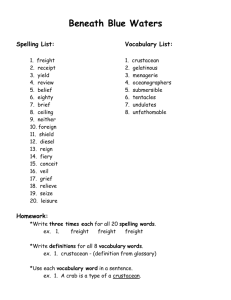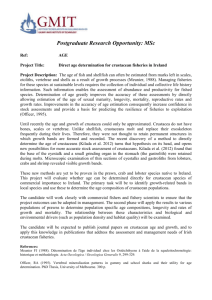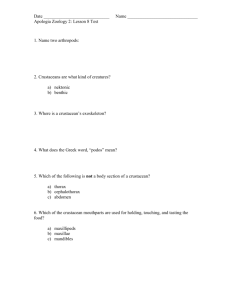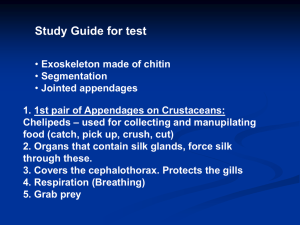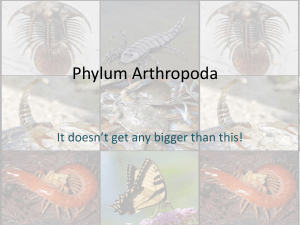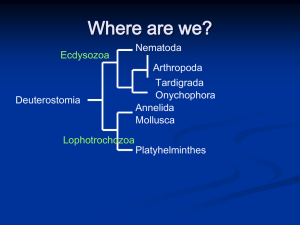Crustacea - Dr. Bondrup
advertisement
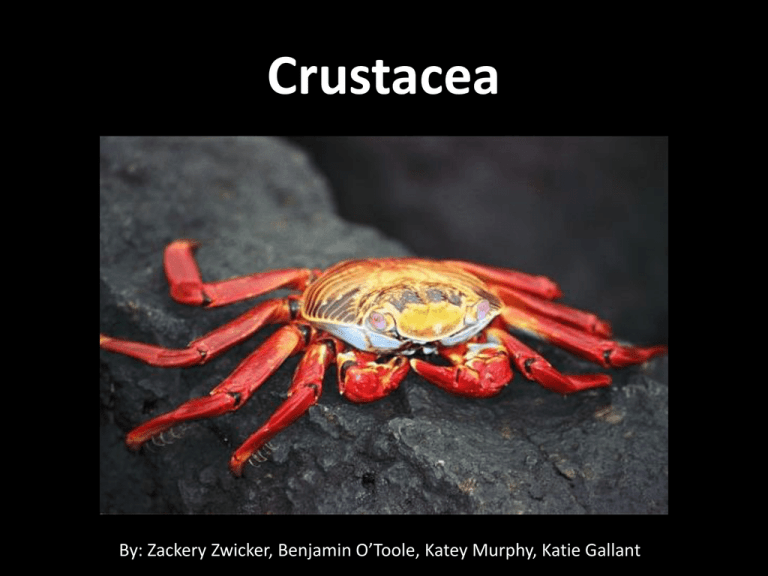
Crustacea By: Zackery Zwicker, Benjamin O’Toole, Katey Murphy, Katie Gallant Evolutionary origin • Attempts have been made to construct a single hypothetical crustacean ancestor. Such an organism would have to possess: “elongated body, two pairs of appendages in front of the mouth, a pair of mandibles behind the mouth, and numerous trunk segments with appendages that form a continuous series of similar structure” • Cephalocarida is proposed as having a body plan from which all crustacean features could emerge Cephalocarida • The earliest crustacean fossils are ostrocods. • There is evidence from the Burgess shales that many crustacean features had already evolved during the Cambrian Period (542 million to 488.3 million years ago) Ostrocod fossil Anatomy • Haemocoel: The body cavity in which blood flows • Sensory Organs: Compound eyes, statocysts (fluid filled cysts that sense direction of gravity), tactile hairs that respond to pressure or touch • Respiration: Diffusion or gills • Central nervous system: Brain and ventral nerve cord Reproduction • Crustacea produce from eggs which have been fertilized by sperm • Most of the species are dioecious, there is a male and a female. • Most species brood their eggs, meaning they have many eggs that hatch at the same time. Habitat Crustacea live in: • Oceans • Fresh water • Land • Many crustaceans are nocturnal • They spend their days hidden in a burrow, buried in the sand or sleeping in a crevice. Diet • • • • carnivores or scavengers some are herbivores and detritivores few classify as parasites eat plants while some eat fish and other feed from the bottom of the ocean Species of Crustacea • There are many species of Crustacea known, 67000, many of these are used for human consumption Semibalanus balanoides (Acorn Barnacle) • • • • • Grow up to 15 mm Can produce up to 10,000 eggs Sessile No abdomen Feed using Cirri Talitrus saltator (Sand Hopper) • Compressed laterally • “Beach Fleas” • 8.2-6.5 mm long • Known for hopping patterns Homarus americanus (Atlantic Lobster) • 20-61 cm • .45-4.1 kg • Lives in cold shallow water • Same Order as crabs • Culinary Delicacy Euphausia superba (Antarctic Krill) • Grows to 6 cm in length • Weigh up to 2 grams • Most abundant species • Bioluminescent Bibliography • • • • • http://www.reefed.edu.au/home/explorer/animals/marine_invertebrates/crustaceans http://www.britannica.com/EBchecked/topic/144848/crustacean/33813/Evolution-and-paleontology http://whyevolutionistrue.files.wordpress.com/2010/03/cephalocarida.jpg http://www.nhm.ac.uk/resources-rx/images/1017/silurian-silicified-ostracod-fossil_71605_1.jpg http://www.britannica.com/EBchecked/topic/144848/crustacean/33813/Evolution-and-paleontology
